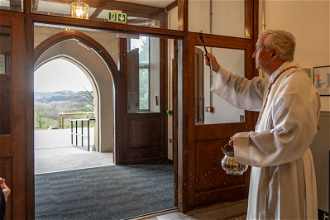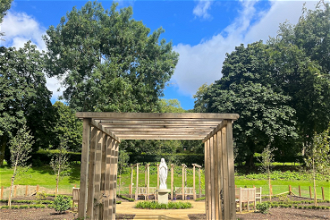Ampleforth and Hull churches receive Grade 1 Listing

St Charles Borromeo Church
Ampleforth Abbey Church and St Charles Borromeo Church in Hull have had their listing upgraded to Grade I on the advice of Historic England (formerly English Heritage)
The Roman Catholic Abbey Church at Ampleforth was designed by Sir Giles Gilbert Scott, one of the most eminent architects of the 20th century. Scott is best known for designing Liverpool Anglican Cathedral, Waterloo Bridge and Battersea Power Station, as well as the iconic K6 red telephone box.
Ampleforth is home to a community of more than 70 monks and Scott's building reflects the pared back simplicity encouraged by the Benedictine order. The Abbey also plays a central part in the lives of the staff and students of Catholic boarding school Ampleforth College.
Built in two phases, the Abbey Church illustrates the way that Scott's architecture developed through his life: the first phase, the east end built in the 1920s, is highly ornamented with dark coloured carved stonework; the second phase, the central tower, nave and transepts started in 1958 and completed in 1961 after Scott's Death, is streamlined and much brighter.
The church of St Charles Borromeo in Hull has long been considered a hidden gem. Behind the Jarratt Street façade is arguably one of the most opulent and dramatic interiors of any 19th-century church in England. Inspired by the Italian Baroque and Austrian Rococo, some of the decorative work was carried out by Austrian craftsman Heinrich Immenkamp who was a local resident. The classical exterior and grand porch was added in 1894 by Hull firm Smith, Brodrick and Lowther. The upgrade to Grade I celebrates Hull's significant heritage in the run up to Hull City of Culture 2017.
These two contrasting buildings now join the likes of Grade I landmarks including York Minster, Rievaulx Abbey and Queen Street Mill, Burnley. Grade I buildings are of exceptional interest and only around 2.5% of listed buildings in England are Grade I.
These significant listing upgrades come at the end of a partnership project between Historic England and the Roman Catholic Diocese of Middlesbrough and the Patrimony Committee of the Bishops' Conference. This is part of a rolling programme of research into Roman Catholic church buildings throughout England.
David Evennett, Heritage Minister, said: "These two churches are a wonderful example of the remarkable architecture Yorkshire has to offer. I am delighted that this upgrade will provide extra protection for these churches and also highlights Hull's rich architecture as we look forward to the 2017 City of Culture celebrations."
Sophie Andreae, Patrimony Committee of the Catholic Bishops' Conference, said: "It is very exciting that the importance of Catholic heritage is now being
recognised. These outstanding churches deserve to be better known and we are very grateful to Historic England for their support for the major research project that has led to this announcement."
Fr Terence Richardson OSB, Prior of Ampleforth Abbey, said: "The Abbey Church is at the centre of the monastic life here at Ampleforth and we are delighted that the classic design by Sir Giles Gilbert Scott is now recognised as of national importance."





















